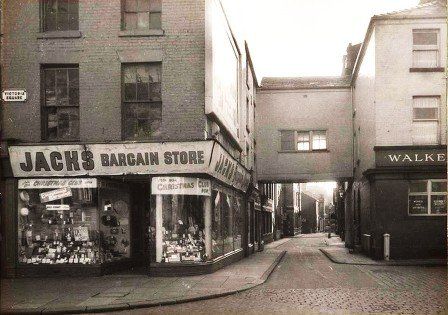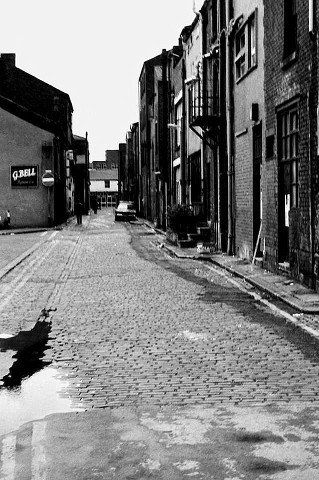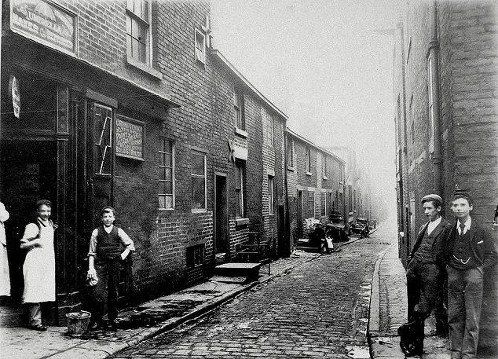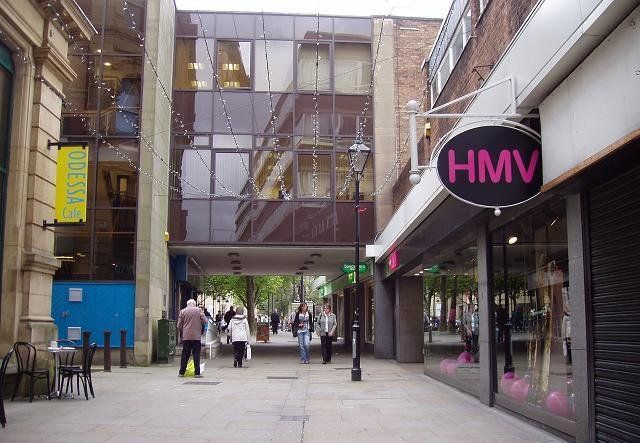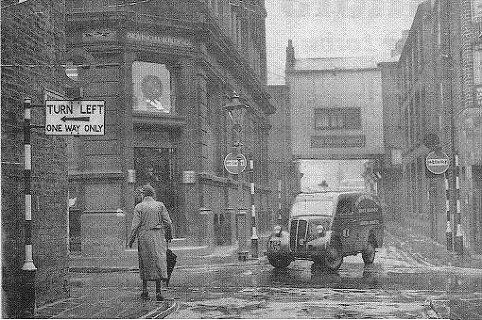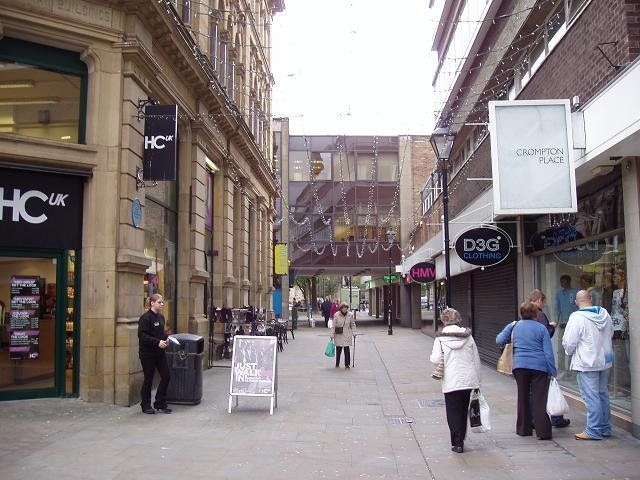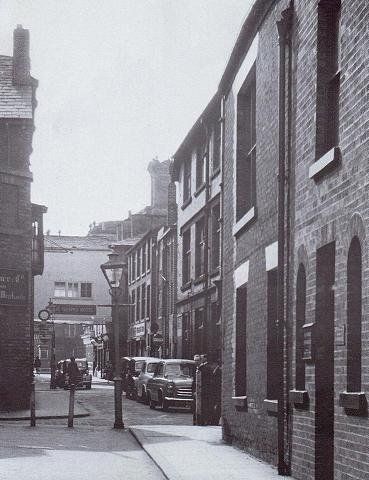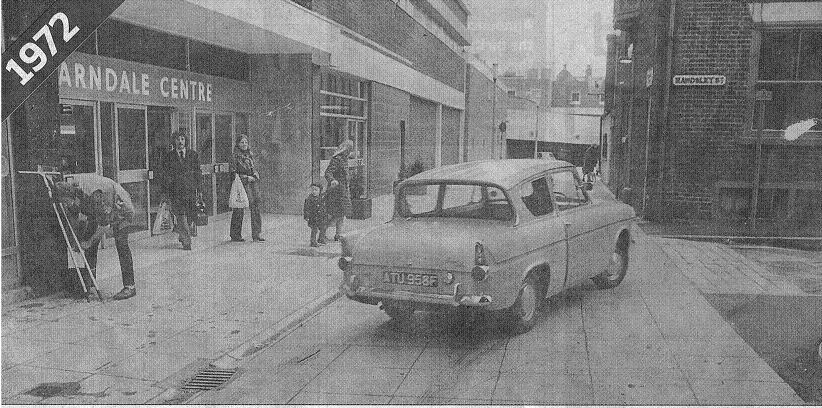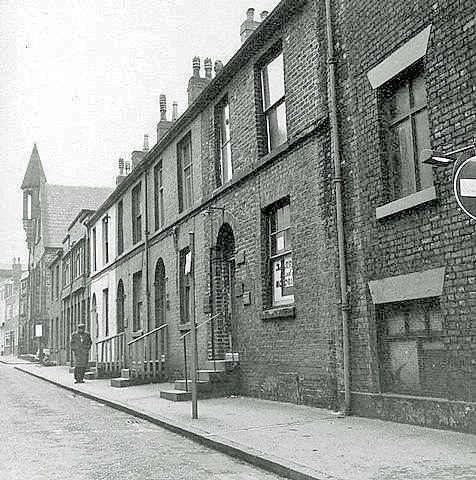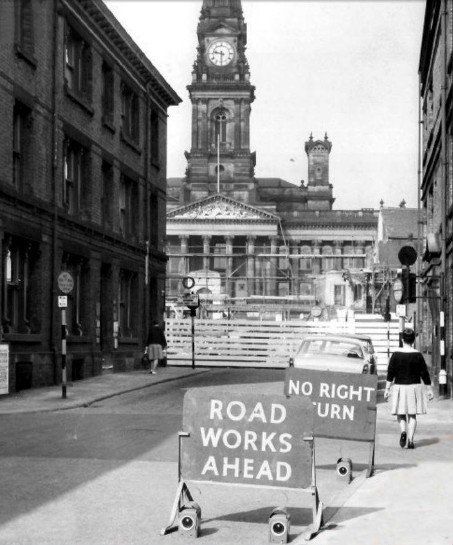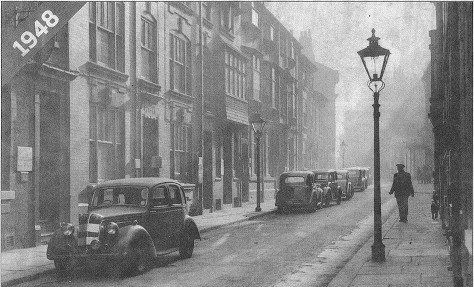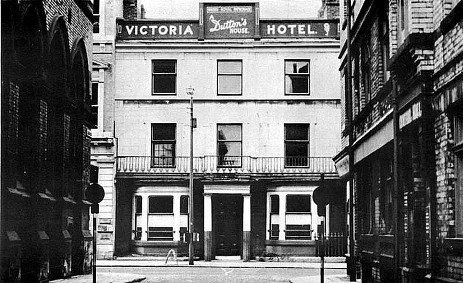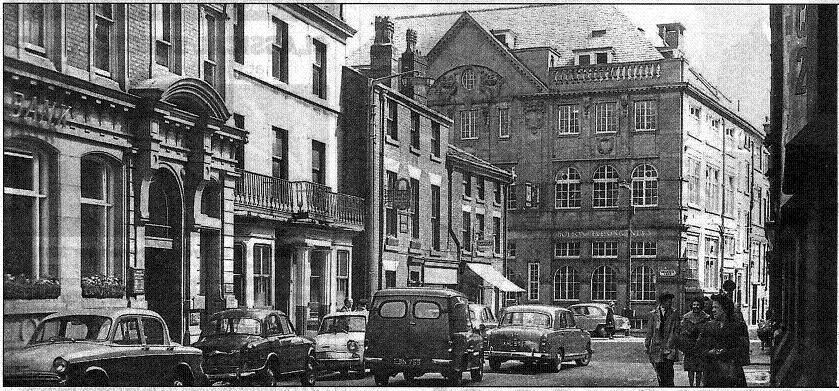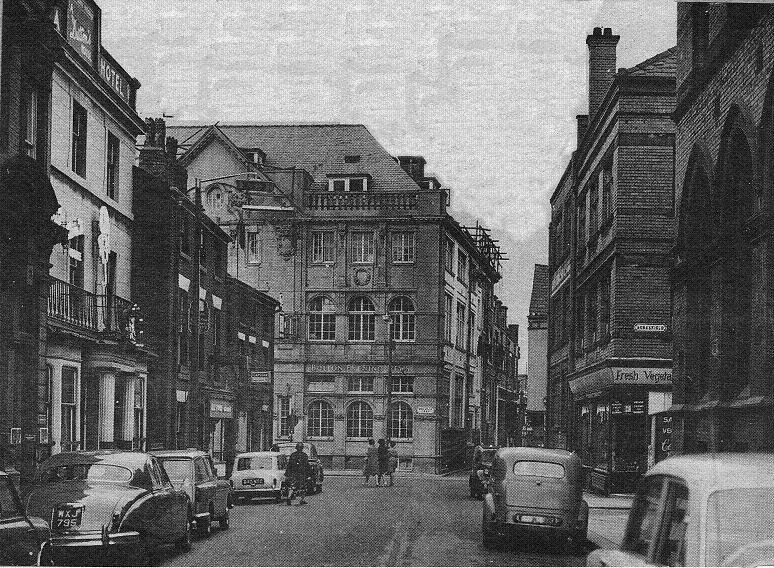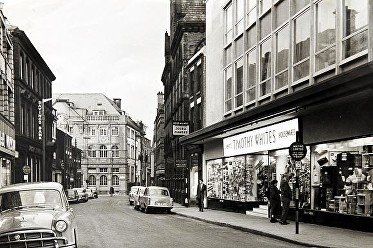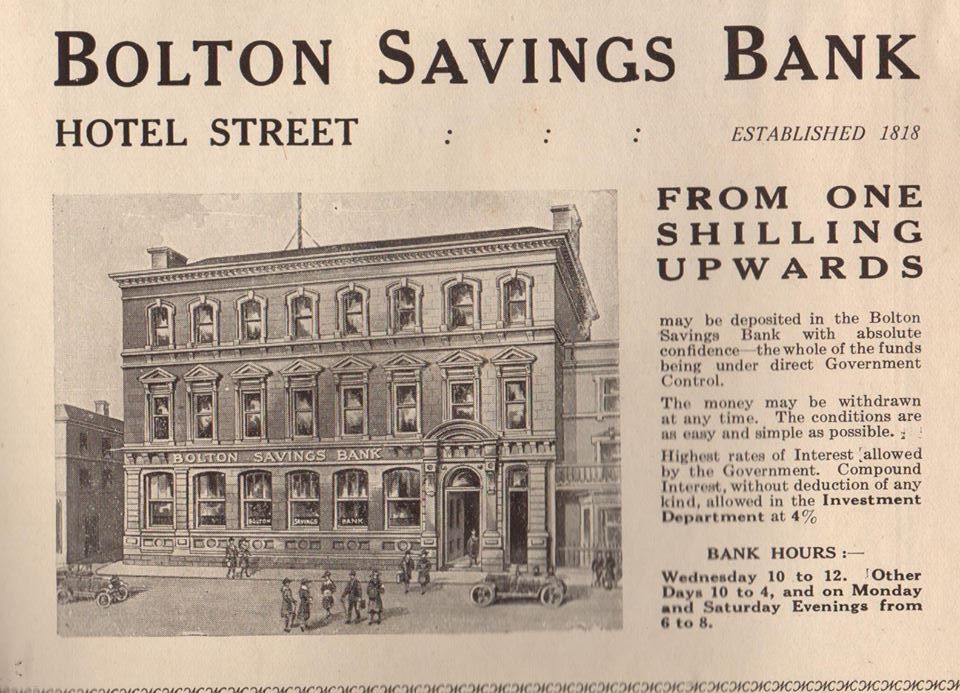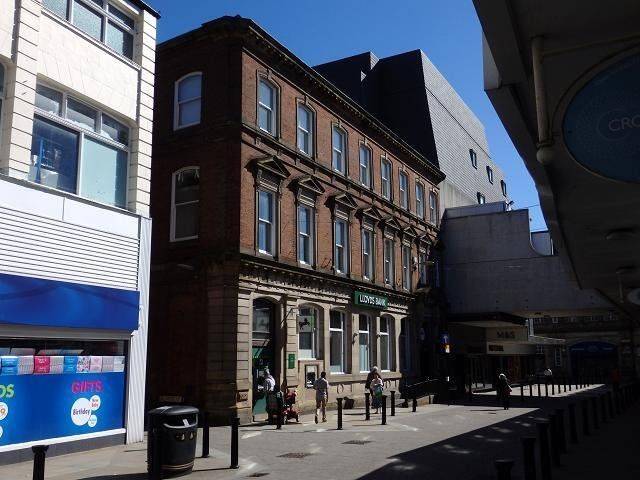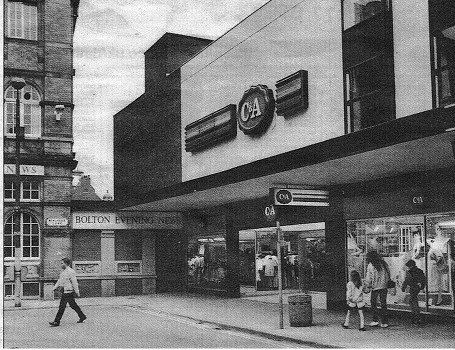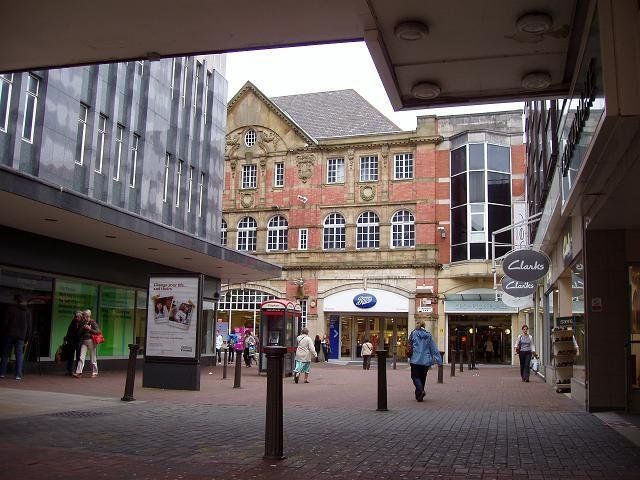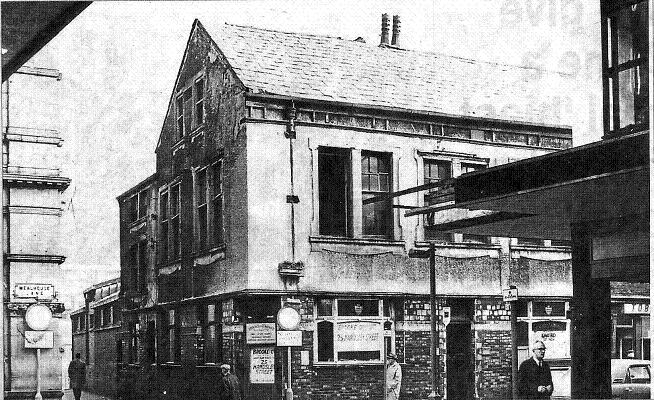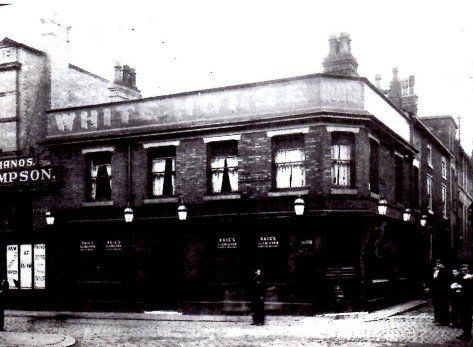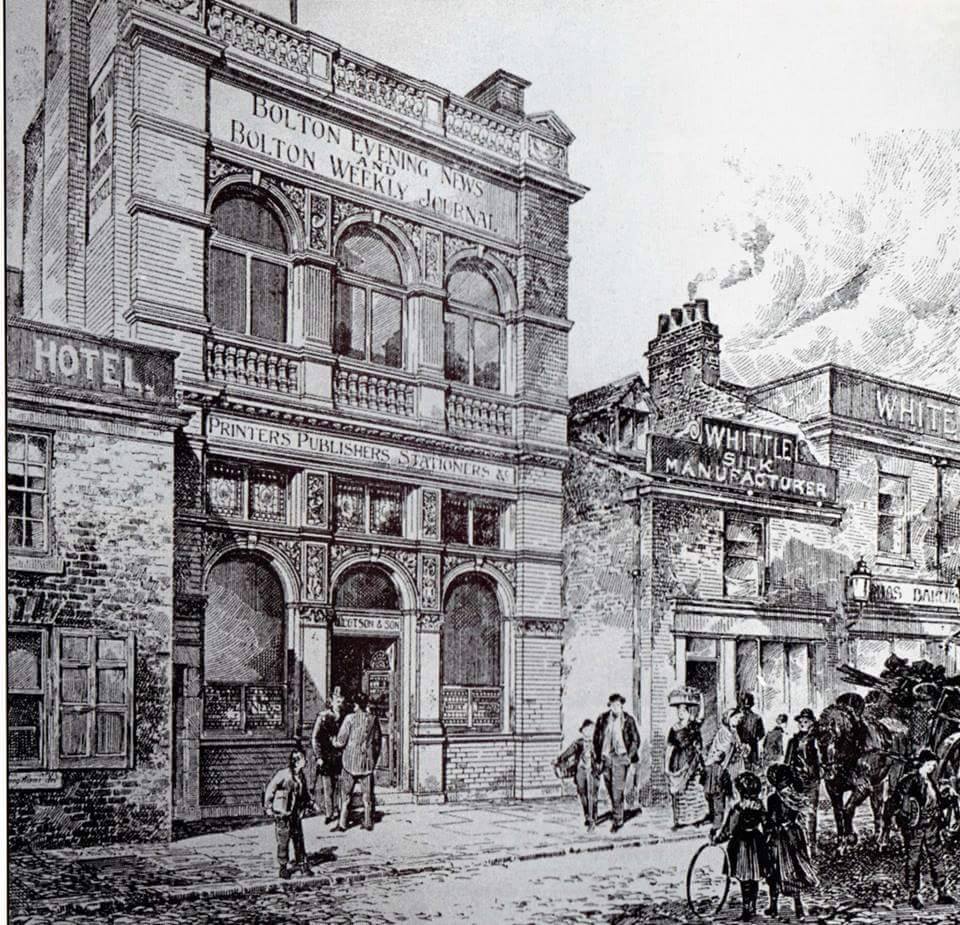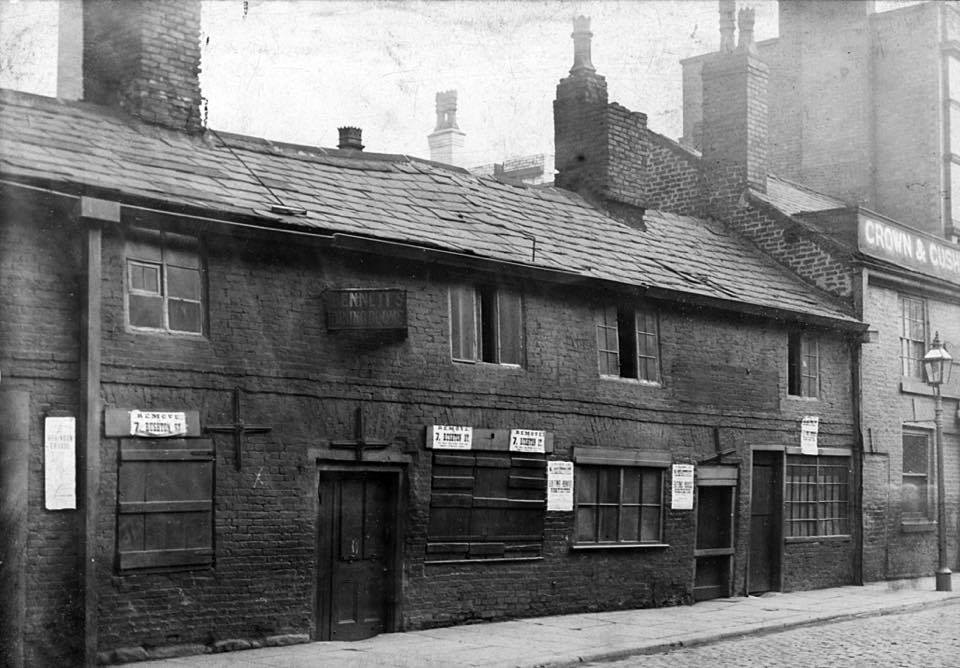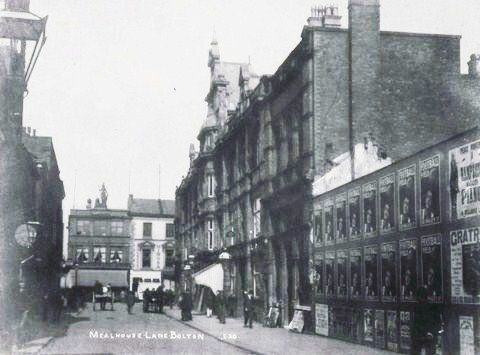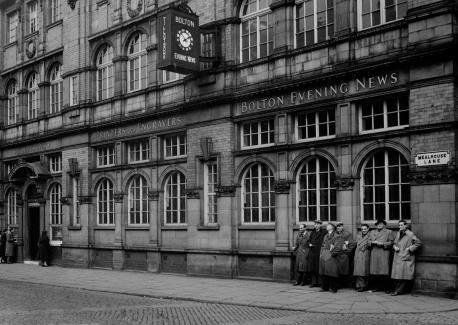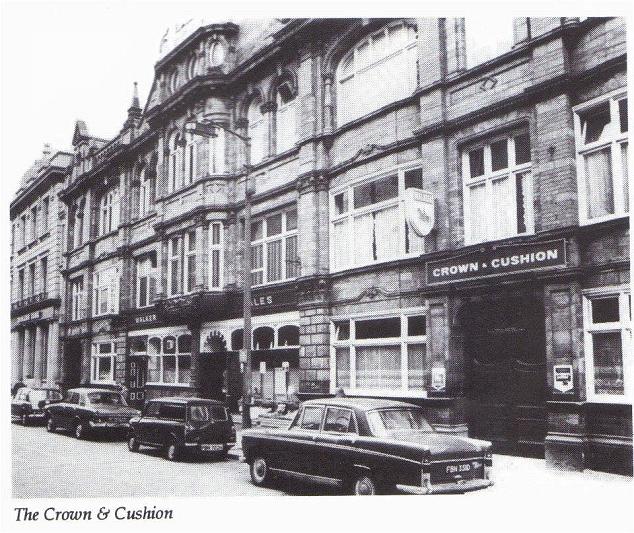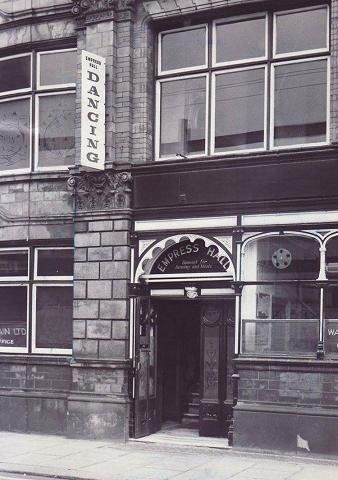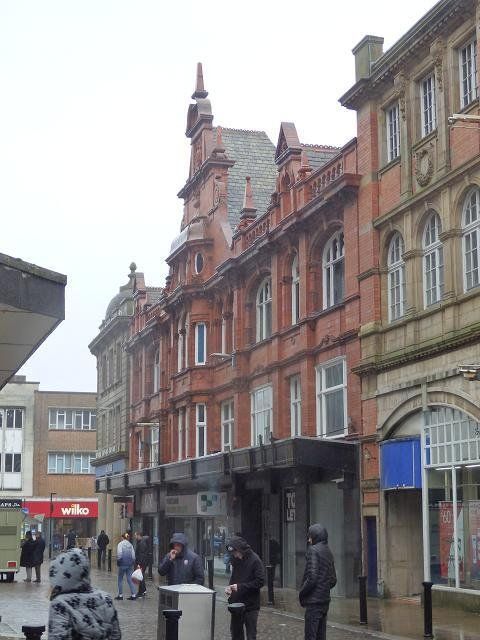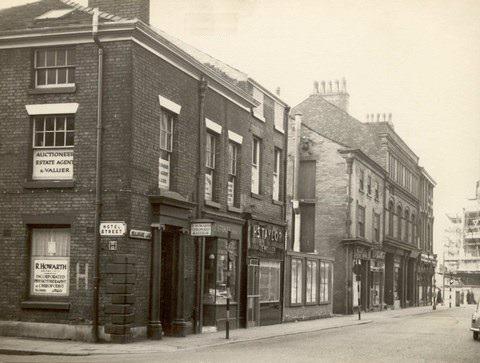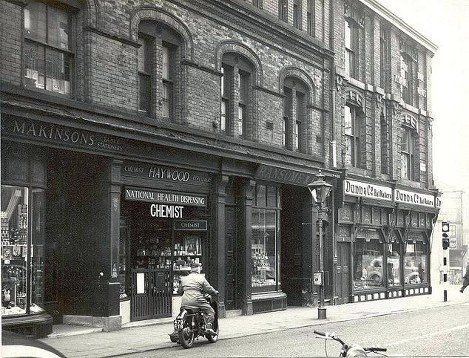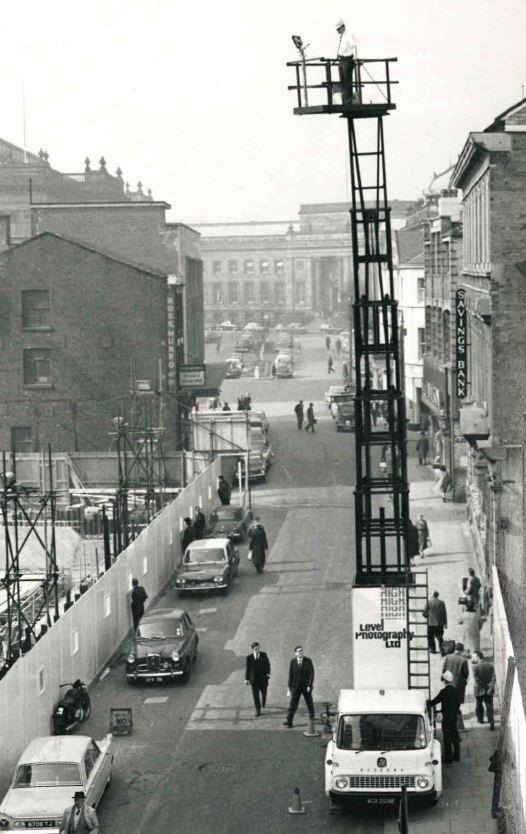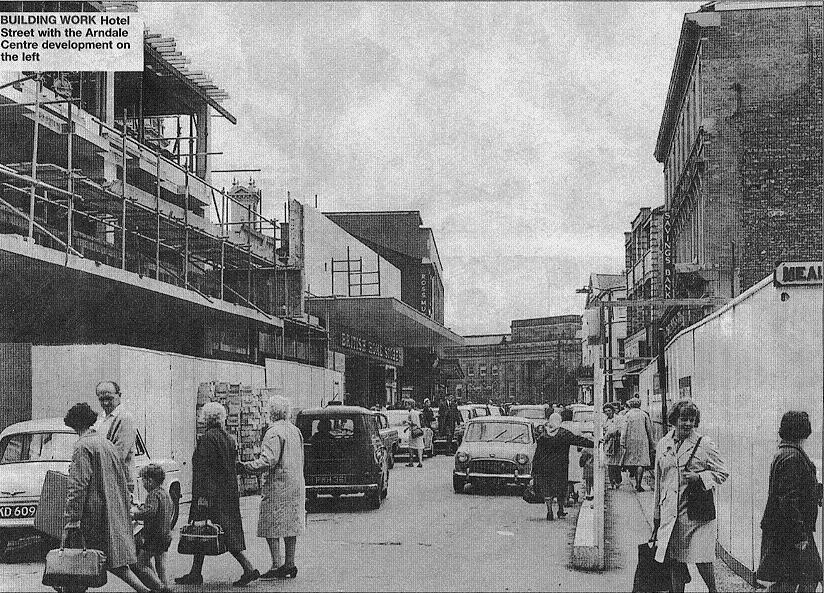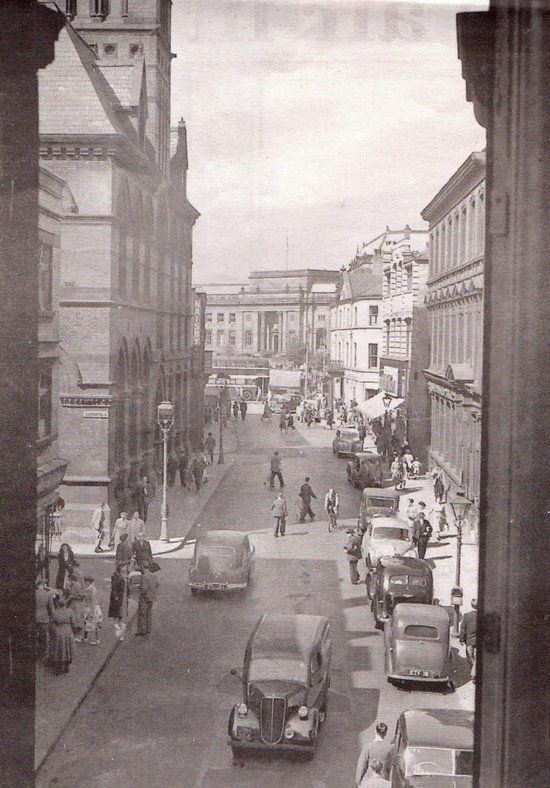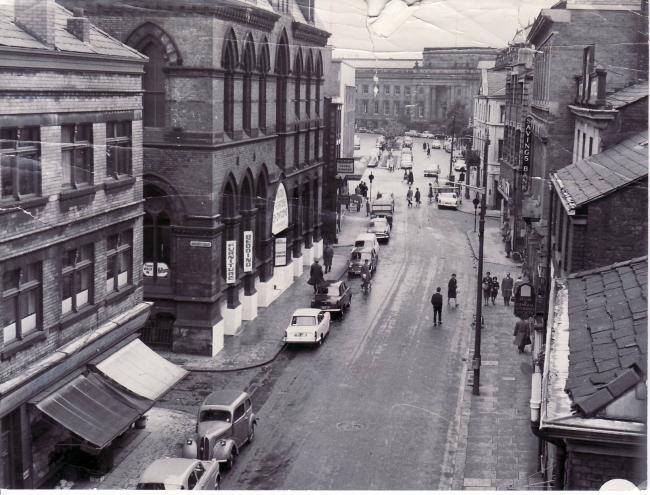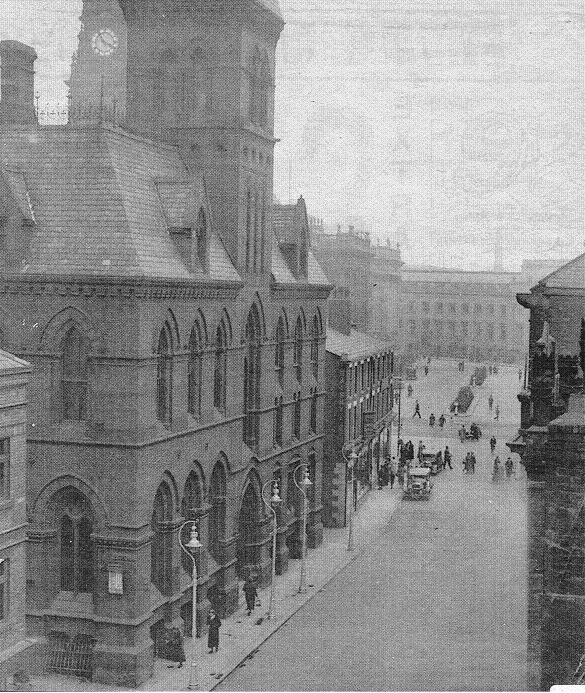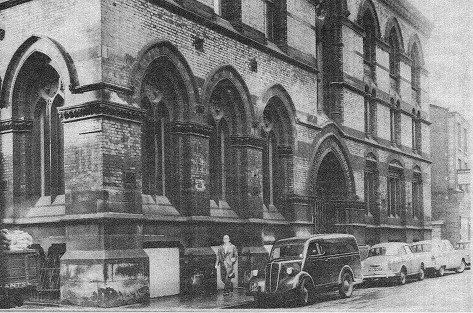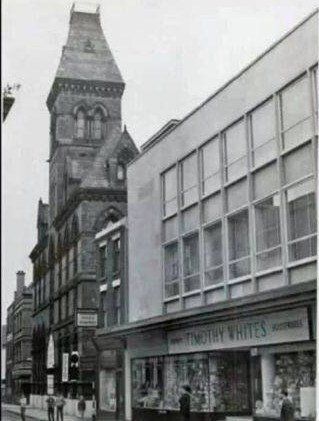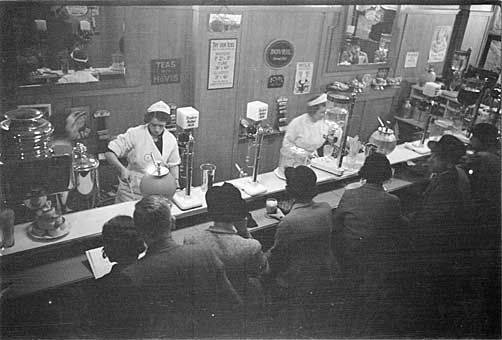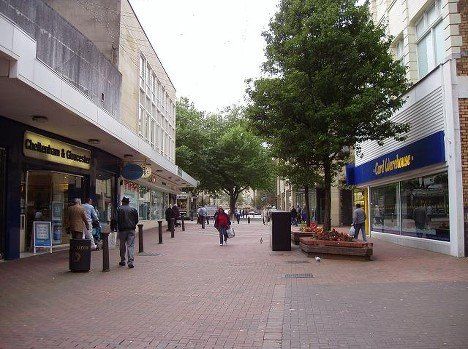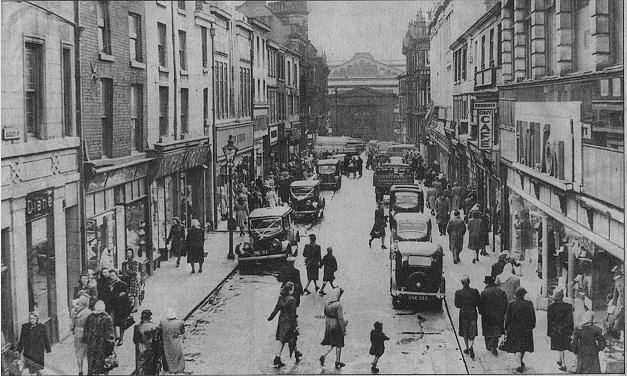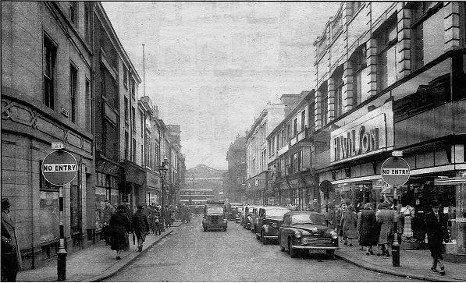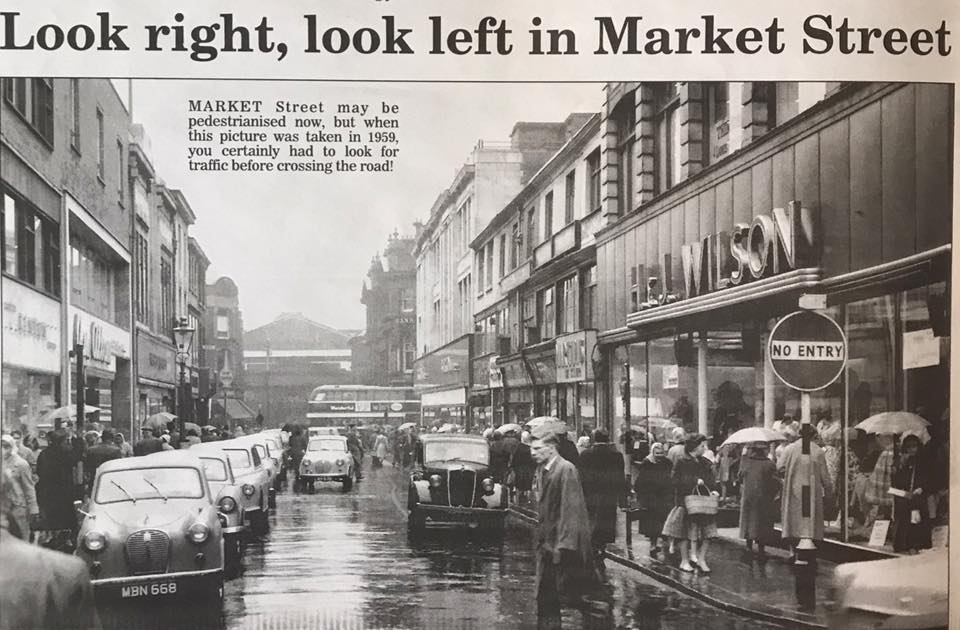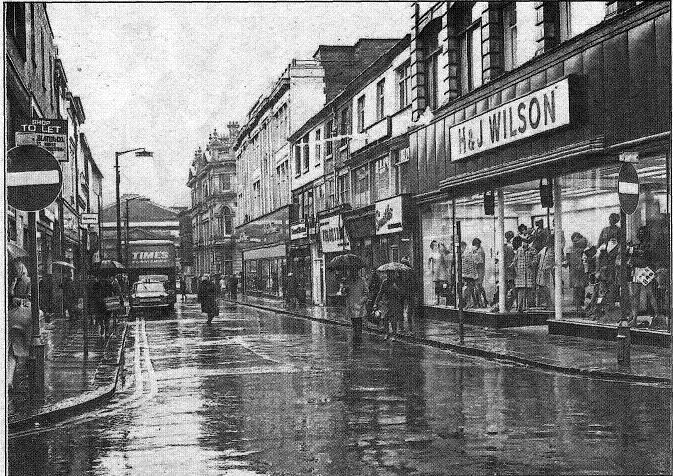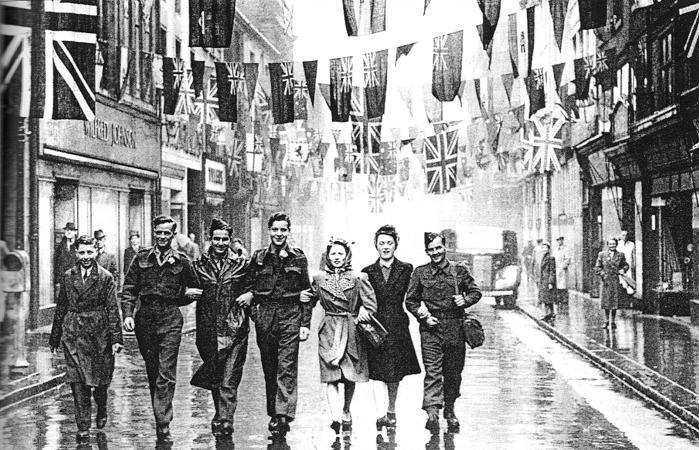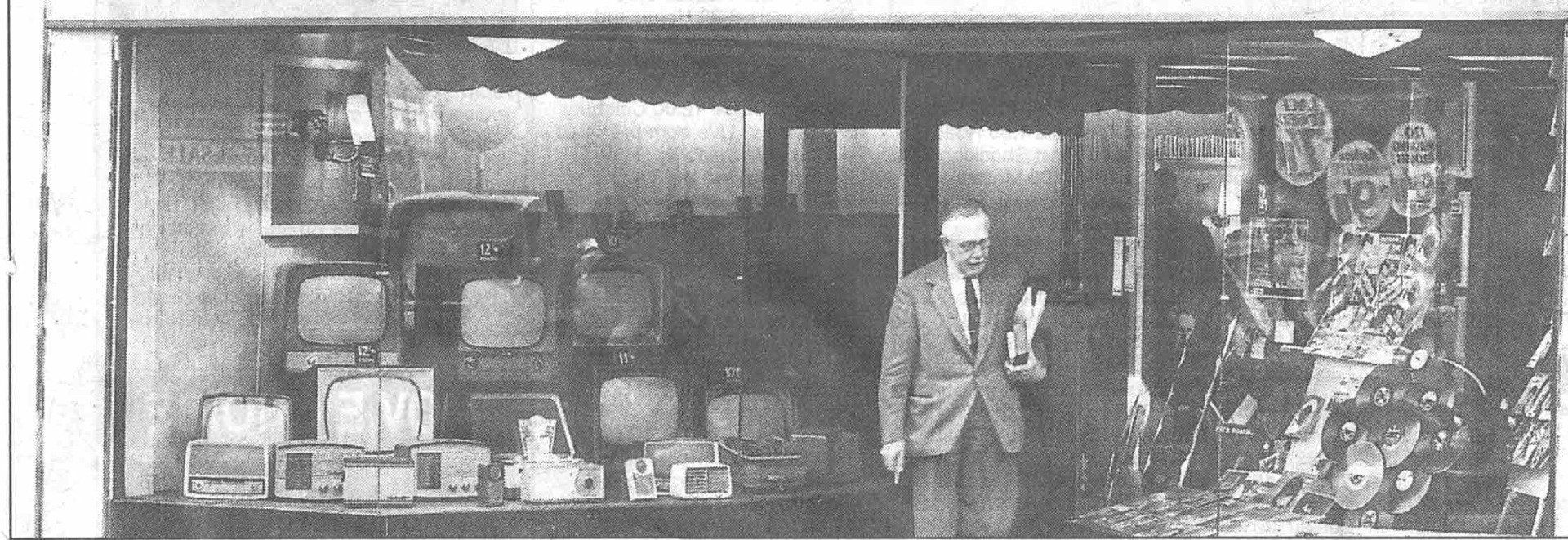We take a last look at the southeast corner of Victoria Square before going under the bridge. First a very old picture of Grapes Hotel
Grapes Bridge and Exchange Street with Jack’s Bargain Store on the corner
Before going under the bridge look to the right between the Grapes Hotel and the old Library Building into Back Cheapside. This runs all the way along the back of Newport Street to Bold St. There has never been a (front) Cheapside in living memory but Newport Street between Exchange St and Ashburner Street was formerly Cheapside. This street still exists but Bell's is only a memory. Many people remember it for the bus staff social club
c1896 looking left:-
Sometimes thought to be Back Cheapside but it almost certainly is Back Acres looking north from Exchange Street behind the old Victoria Square shops. The shop is Walter Parkinson's Umbrella shop whose main entrance was on Exchange St almost in the same place as HMV was in recent times. Back Cheapside is straight and didn't have steps to the back doors, whereas Back Acres did. The evidence is compelling. (Peter Lodge) Walter Parkinson also a barber.
Dates of interest and significance for Bolton
1251 A charter permitting a market in Churchgate has the first reference to “The Man and Scythe”. (Wikipedia has this date and many other sources may have copied it. A second charter was issued in 1253. The 1256 date is possibly incorrect)
1253 Bolton becomes “a free Borough by Charter”
1256 Henry III grants a market charter to Bodelton
1554 George Marsh. A protestant preacher was arrested at Smithills Hall on charges of heresy during the counter-reformation of Queen Mary. Refusing to recant he is said to have stamped his foot so hard that he made an imprint in a flagstone still visible today. He was taken to Lancaster and Chester and given a number of opportunities to return to Roman Catholicism but was burned at the stake near Chester in April 1555.
1636 The Man and Scythe is thought to have been rebuilt retaining the cellars which were strengthened but nothing above ground of the original building. The wattle and daub building was replaced with brick. Ownership passed to the Plkington family in the early 1300s at which time that family crest of the Man and Scythe was adopted by the pub. That invites the question, “Where did the name recorded in 1251 come from?” Coincidence? Ownership returned to the Earl of Derby estates in 1485. 1850 part of the pub was destroyed by fire and the subsequent rebuilding is essentially what we have today. Around 1900 the brickwork was painted to give a black and white timbered appearance. The present faux-Tudor half timbering was added in the early years of the 20th Century.
1641 Grammar School founded
1644 28 May, Prince Rupert’s army overcome the Bolton defences resulting in the “Bolton Massacre” of the civil war.
1651 15th October, Earl of Derby beheaded in Churchgate
1661 “Bowlton hath a market on Mondays which is very good for clothing and provisions and is a place of great trade for fustians.” (Blome’s Britannia)
1721 Boar’s Head on Churchgate built (closed 1992, demolished 1998)
1753 Samuel Crompton born
1760 Richard Arkwright’s barber’s shop was on Churchgate
1777 16th April John Wesley opens Ridgway Chapel, predecessor of Victoria Hall
1777 St Helena Mill built
1786 The Market Cross was removed from Churchgate it having been said that it caused congestion. A late 19th Century photograph shows it (if you look carefully and know what you are looking for) by the wall of the Grammar School in the parish Church grounds. It has resided for many years in the grounds of Bolton School.
1791 Bolton canal opened
1796 St George’s Church opened
1808 Great Moor Street /Mawdesley Street Congregational Church founded
1813 Nelson Square, a small health office opened – no in patients at this stage (see 1838)
1818 11th February, Bolton Gas Company established
1819 BGC supplied gas lighting and household gas through most of Bolton
1819 Parish Church School built on corner of Silverwell Street and Churchgate
1820 Thomas Bonsor Crompton patented a method of continuously drying paper (world first) a breakthrough in paper manufacturing. Crompton Lodges at Moses Gate remains from his paper making enterprise – no relation to Samuel Crompton.
1824, July 30th the Trustees of Little Bolton held their first meeting in the partially completed town hall which officially opened Feb 7th 1828
1958
Exchange Street looking back under the bridge to Victoria Square. The street across is Back Mawdesley Street.
24 September 2009
The scene in more recent times though sadly HMV has now disappeared. Acresfield has been totally covered by the Arndale, now the Crompton Centre.
Back off a little, still Exchange Street, on the left is Mawdesley Street, on the right Acresfield along which we travel shortly.
2009
Back off a little more. Exchange St looking across Chancery Lane towards Grapes Hotel Bridge
1827 26 June. Samuel Crompton died
1828 Bolton Leigh railway opened but no evidence of a regular passenger service until joined with Manchester Liverpool railway 1831
1828 7th February Official opening of Little Bolton Town Hall. Little Bolton became a Parish in 16621831 the original (ground level) Great Moor Street railway station opened
1835 Greater Bolton most of Little Bolton, and Tonge with Haulgh amalgamated as a Municipal Borough, the second to be created in England, part of Rumworth added 1872, part of Halliwell 1877, Breightmet, Darcy Lever, Great Lever, the rest of Halliwell, Heaton, Lostock, Middle Hulton, the rest of Rumworth which had been renamed Deane (in 1894) Smithills, and Tonge plus Astley Bridge Urban District, and part of Over Hulton in 1898
1835 The Wheatsheaf built on the corner of Newport Street and Great Moor Street
1835 the “model industrial village” was built at Barrow Bridge by Thomas Bazley and Robert Gardner founders and owners of Dean Mills. The village integrated all social, educational and economic life. Prime Minister, Benjamin Disraeli visited Barrow Bridge and used it, renamed Millbank, in his novel Coningsby.
1836 Legs of Man on Churchgate first opened
1837 Queen Victoria accession to the throne
1838 Bolton’s Charter of Incorporation
1838 Nelson Square health office – from this date some patients were given beds in an emergency but some time after this about sixty beds were provided
1838 29 May, Bolton to Manchester railway line opened.
1838 9 November, George Henderson of Annan, Dumfriesshire was murdered on Winter Hill and is commemorated by the Scotsman’s Stump. The present iron stump was erected in 1912 a previous wooden memorial said to have been “whittled away by generations of souvenir hunters”.
1839 16 August; A Chartist riot saw the Parish Church occupied and the Little Bolton Town Hall (no longer the centre of government of the combined town but continuing to be used as a police station and lock-up) damaged. The Mayor of Bolton (the first after incorporation) had to read the Riot Act and call in a troop of Grenadiers from the 96th Foot Regiment.
1842 Blinkhorn’s chimney in Kay Street was built and at 367½ feet tall was reputed to be the highest in the world.
1847 Bolton Trinity Street to Preston line opened.
1847 Bridgeman Street Baths opened (built 1845, closed 1976) These were the first municipal baths in the country.
1851 William Hesketh Lever born at 16 Wood Street
1853 Magee’s Crown brewery was founded in 1853 by David Magee, Derby Street Cricket Street . it closed in October 1970 having been taken over by Greenhall Whitley.
1853 12 October, Bolton Public Library established
1855 Church Institute, Silverwell Street opened, became Canon Slade School in 1946 (moved to Bradshaw 1959) demolished 1969
1855 19th December, Market Hall, Knowsley Street opened
1856 Bank Street Unitarian Church original building opened.
1861 Bolton Institute workhouse built at Fishpool farm on the Farnworth border to replace a workhouse in Fletcher Street and a “Casual or Tramp Ward” on Kings Gate (King Street in the Bolton town centre?). This was not at this stage a hospital or infirmary.(see 1875)
1862 Statue of Samuel Crompton dedicated in Nelson Square
1865 Bridge Street Fish Market opened alongside the Market Hall.
1867 The Bolton Workshops for the Blind first opened in Tipping Street; see also 1914, 1930
1867 The Bolton Evening News was established, the first halfpenny evening paper in England. A plaque on what was for many years the newspaper offices reads, “The Bolton Evening News was first published by W I? TILLOTSON from the Albany on this site, 19th March 1867.
1868 (1866?) old Parish Church demolished
1868 Dr and Mrs Chadwick deposited £17,000 with trustees for the building of “model dwellings” and an orphanage as a New Year gift to the Town. See also 1879, 1884.
April 1972
About turn; looking down Exchange Street away from the Town Hall Square, across the end of Mawsdesley Street. The Arndale Centre is on the left and Exchange Street seems to be pedestrianised, though in April 1972 the driver of the Ford Anglia is perhaps in some doubt about that.
1960 or 62
Bowkers Row with St Andrew’s Church
As we progress down Exchange Street we cross Acresfield and Mawdesley Street, then Chancery Lane, then Bowker's Row pictured here. The tiny bell tower is on St Andrew's Church, still remembered by St Andrew's Court, a small shopping centre on the corner of Mawdesley Street and Exchange Street.
As we go down Exchange Street we can turn left into Acresfield or right into Mawfesley Street one being th continuation of the other. Mawdesley Street still exists. Acresfield has been totally obliterated by the Arndale Centre (now Crompton Centre) but that is the way we shall go.
1950s
Acresfield looking to Hotel Street and the Victoria Hotel. This street is now covered by Crompton Place. Marks and Spencers has replaced the Victoria Hotel. My memory of this is walking along in the early evening and seeing on the front of the VH a large illuminated OBJ. It is not on this picture but if we continue along and turn into Hotel Street, we see it on a picture just lower down the page.
On the right is Fold Street. During the construction of the Arndale Fold Street was temporarily opened up on the left towards the Town Hall. It seems that creating a through road here is in the plane for the 2021 reconstruction of this area.
Fold Street 1964. This originally came from Bradshawgate to Acresfield but when the buildings between Acresfield and Victoria Square were demolished this view through to the Town Hall was revealed. Chancery Lane crosses in the foreground. The warning signs were in position to alert motorists to the road works connected with the installation of a new sewer which had already been started in Mealhouse Lane.(Bolton News)
Nov 1948 Looking back the other way:-
Acresfield - much of the town's legal and financial business here - looking towards Mawdesley Street and Great Moor Street.
1868 The Bolton Mechanics Institute built premises in Mawdsley Street and their previous premises in Oxford Street were taken over by the Library and Museums Committee for use as a Central Lending Library
1868 23 November, Bolton Gas Company open their Offices on Hotel Street
1869 Preston’s opens on Bradshawgate
1869 decision to clear slums around Grime Street (later St Edmund Street) and to build a High Level Bridge from Deansgate / Moor Lane to St George’s Road. Legal power for the construction was obtained in 1870. The bridge was opened in 1877
1869-70 A main interceptor sewer was finally constructed to accept waste that had previously entered the Croal all along its length and to discharge it below the town at Burnden. During the time a national River Pollution Board was formed so some rudimentary sewage treatment had to be done. A little later this was transferred further downstream to Hacken Lane, completed in 1886.
1870 30 November, the new Bolton School Board was formed.
1871 29 June, The new Bolton parish church was consecrated
1871 27 October, the new Wholesale market was opened. See 1875
1871 30 November, a riot occurred at the Bolton Temperance Hall in which one man received injuries from which he later died when a mob objected to the presence of the invited speaker, Sir Charles Dilke, one of the most left-wing members of the Liberal Party and a well known Republican and anti-Royalist.
1872 Bolton Corporation take over Bolton Gas
1872 The New Market Place was renamed as The Town Hall Square. Its name was changed to Victoria Square in 1897
1873 Town Hall constructed; opened 5th June 1873 by the Prince and Princess of Wales, later Edward VII and Queen Alexandra
1873 The Bolton Royal Infirmary was built just off the bottom of Chorley New Road to replace the Nelson Square facilities, originally with 84 beds but eventually around 224.
1874 Bolton Wanderers formed
1875 7 June; The first “Board School” to be built by the Bolton School Board was opened at Pikes Lane. The street alongside is called Board Street. Second one 1881. However the Board took over the British School in All Saints Street in May 1871. Board Schools became part of the Council Education Department in 1903
.
1875 Great Moor Street Station rebuilt and reopened. The station closed for regular services in 1954 though was used at holiday times for North Wales until 1958. It was finally demolished in 1970.
c1875 – The Hollins Cottage Homes were set up adjacent to Fishpool but separated from it with its own access to Plodder Lane. The purpose was to accommodate orphan or pauper children who might otherwise have been placed in the Workhouse which was essentially for adults. It was later extended. (see 1910)
1877 Marsden Road High Level Bridge was opened.
1878 17th January, One of the first telephone lines in the world connected the Gas Offices with the gas works.
1878 Marsden Road High Level Bridge opened
1878 Bolton, Farnworth and Astley Bridge obtained powers for the construction of tramways with the first rails being laid on Marsden Road on 23 October 1879.
1879 The Chadwick Museum, Park Road, inside Bolton Park (later Queen’s Park) was completed but the cost had been more than the £5000 left by Dr Chadwick and final furnishing and equipping was delayed. In 1881 Mr J P Thomasson gave £1000 and other gifts were received from the people of Bolton . See 1884.
1879 22 December first interment in Heaton Cemetery. Burials took place seven days a week until Sunday burials were discontinued on 1 January 1881.
1880 A grand building was constructed on St George’s Road for the Junior Reform Club. It became the Spinners’ Hall in 1886 when purchased by the Bolton Operative Cotton Spinners' Association, then the wealthiest society of its kind in the country.
1880 1 September, start of the (horse drawn) tram service
1881 Bolton Wanderers signed James McKernan from Hibernian and to get round the amateur/professional ruling they installed him as publican of the Britannia Inn in Derby St; for some considerable time the Britannia was the headquarters of the Wanderers after they left Christ Church, Pikes Lane.
1881 7 May, the second “Board School” was opened as the Haulgh Board School financed at a cost of £6000 by J P Thomasson MP who also gave Thomasson Park (Mere Hall) to Bolton.
1883 Bolton Royal Infirmary opened 21 August and the Nelson Square infirmary closed.
1883 Borough Fever Hospital, Hulton lane opened 25 August
1884 The Chadwick Museum was opened.
1884 Horwich Locomotive Works were established by Lancashire and Yorkshire Railway.
We reach the end of Acresfield with Hotel Street across its end. The Vitoria Hotel dominates. There is no large or illuminated OBJ sign but we have a coule of smaller painted ones.
1960 Hotel Street looking towards Shipgates and Mealhouse Lane where the Tillotson’s, Bolton Evening News Office still was. The Bolton Evening News founded in 1867 was the first halfpenny evening paper in England. The left is now M&S. The right is Crompton Place. On the left is the corner of the Trustee Savings Bank which is still there though now Lloyds and the Victoria Hotel with its OBJ sign, which is no longer there.
June 1961 a clearer view down Ship Gate. The illuminated OBJ sign can be seen on the Victoria Hotel.
1961 we see the new Timothy White's building. The Arndale Centre behind it has yet to be started. The Double Diamond sign is on the Ross Munro premises. This had once had a larger frontage on Victoria Square until Naisby's expanded.
Posted on Facebook by Gene Watts. The Bank became Trustee Savings Bank which is how many of us will remeber it. It was involved in the Lloyds TSB merger and sadly when the demerger took place it became a branch of Lloyds
(WDC) May 2018 The bank is now Lloyds. The rest of the block is now occupied by Marks and Spencer's
1885 The Bolton and Leigh Railway was rerouted between Fletcher Street and Daubhill. The Rumworth and Daubhill station was opened.
1886 Silverwell Street Drill Hall built, attached to the front of Silverwell House
1887 Victoria Golden Jubilee year
1889 Bolton became a County Borough
1890 August, The College of Arms authorised the use of the Borough’s arms by a Grant of Arms
1890 Mere Hall and Thomasson Park were opened. Mere Hall had been built as a private residence in 1836 for /by Sir Benjamin Dobson. Thomasson bought this with the express intention of giving it to the town fully equipped as a public park, library, museum and art gallery.
1892 Marks and Spencer opened a stall in the Market Hall
1893 February, Nelson Square was laid out as a garden
1893 The lending library SW corner of Victoria Square (now replaced by Wellsprings) opened
1894 Electricity generation works were opened with a capacity of 250kW on Spa Road on Gas Works land.
1894 the plain external walls of the Market Hall on Knowsley Street and Corporation Street were rebuilt with windowed shop fronts
1895 Albert Ward sports shop established on Bradshawgate, closed 1974
1896 September 6 and 13, the Winter Hill Mass Trespass (Winter Hill Right of Way Dispute).
1897 Town Hall Square renamed “Victoria Square” for the Diamond Jubilee
1897 Central Higher Grade School (Municipal Secondary School) later County Grammar School was opened on Great Moor Street.
1897 Co-op drapery on corner of Higher Bridge St / St George’s Rd opened 20 Jan (fire 1902 reopen 1904)
1898 Extension Act brought into the County Borough of Bolton – Astley Bridge, Tonge, Breightmet, Darcy Lever, Great Lever, Hulton, Deane, Lostock, Heaton and Smithills increasing the area of the Borough from 2361 acres to 15,279 acres! This extension was done with the agreement with the agreement of all the areas. Earlier attempts had failed because various areas had objected to being taken over by Bolton. Daubhill as part of Rumworth had been included earlier.
1899 School in Parish Church grounds (behind Church Institute) moved to Chorley New Road and became Bolton School.
1899 1st March hospitals opened at Townleys
1899 20 October, Marsden Road Fire Station opened.
1899 19 December, Hall i’ th’ Wood offered as a gift to the town by W H Lever who had paid for its restoration and equipping as a folk museum – see 1902
1900 all tram routes electrified (some routes from late 1899)
1900 Victoria Hall opened
1901 December, W H Lever gave 360 acres Rivington Pike and surrounding estate to the people of Bolton as a public park and open space. Liverpool waterworks objected to this as likely to be a cause of pollution to their reservoirs. A Parliamentary Committee in May 1902 made the land a “public park for ever” under the care of Liverpool Corporation.
1902 White horse on corner of Mealhouse Lane and Shipgates, closed
1902, 1st June Co-op building at corner of Bridge Street St George’s Road destroyed by fire
1902 23 July Hall i’ th’ Wood officially opened by W H Lever, later Lord Leverhulme
1902 9th August, Some buildings in Bolton decorated for coronation of Edward VII
1903 26 April, High Street Swimming Baths opened (closed 1985). The baths were next to the library, both sites being donated by John Heywood
1903 A experimental motor-bus service to Darcy Lever was tried but was a failure. For a little time afterwards horse-drawn “waggonettes” provided a service.
1903 30 September, the Hilden Street Pupil Teachers’ Centre opened
1904 Trinity Street station opened
1904 Packhorse rebuilt
1905 Tram routes modified so that all routes passed Trinity Street Railway Station – a true Transport Interchange.
1905 Preston’s acquire the site on the West corner of Deansgate / Bank Street
1905 16 Wood Street becomes the home of Bolton Socialist Club
1906 the new building for Yates Bros was open by this time, part of the widening of Bradshawgate completed by about 1910.
1907 King’s Hall, Bradshawgate opened
1907 Whitaker’s opened on corner of Deansgate and Old Hall Street North, then Lion’s Paw on opposite corner was rebuilt in imitation and opened as Silver Vat
Hotel Street, C&A,The low building marked Bolton Evening News blocks entry to Shipgate which originally went through to Bradshawgate via the site of the demolished Ship Hotel. It was closed so that Tillotsons (or Reed or whoever then owned it) could extend their building to install a huge new printing press. Not too long afterwards, printing moved to Wingates and a little later still the offices moved to Churchgate and then to Wellsprings on the Town Hall Square.
September 2009 After Bolton News had moved from here to Churchgate the Gates Shopping Centre (attached to the Arndale) was created in that corner the lead tenant being Boots the Chemist who moved here from their nearby premises in the Timothy Whites building on the corner of Victoria Square and Hotel Street.
To the right is Chancery Lane leading to Great Moor Street; to the left is Mealhouse Lane leading to Deansgate and we can see the edge of the Bolton Evening News building; straight on is Ship Gate. The occupants of this slightly sorry looking building, Brooke and Co have just moved to 25 Mawdsley Street..
Before Tillotson's extended, that corner of Mealhouse Lane and Ship Gate was occupied by the White Horse dating back to 1788.
Tillotson's Bolton Evening News building before it was extended to replace Whittle's Silk Manufacturers and the White Horse. to the left is the Crown and Cushion which a little later extended into the huge building which is still there now.
Picture posted on Facebook by Denis McCann.
Mealhouse Lane. Bennett's Dining Rooms recently abandoned prior to the expansion of the Crown and Cushion seen on the right with the end wall of the Tillotson building to its right.
Mealhouse Lane c1901, looking towards Deansgate. The White Horse closed 1901 and the boards with posters to the right screen the site of the pub and adjoining premises. The building on the right with the bay windows and the decorative structure on top is the rebuilt and very much enlarged Crown and Cushion. Between it and the boards, rather dark and not easy to see, look for the three arches and the change of line of some horizontal details, is the original Tillotson's building. Across Deansgate you can see Britannia on Constantine Bros store which became Woolworth’s.
Who? What? Why?
undated picture posted by David Whenlock. We appear to be looking from the start of building of Marks and Spencers
1907 buildings in Oxford Street demolished prior to building of the Oxford Street Co-op.
1907 further tests of motor buses to Brownlow Fold and Darcy Lever again failed so tram tracks were laid on these routes.
1907 J P Thomasson built a school for the Blind and deaf on Devonshire road – rebuilt 1954.
1908 The New Empire Theatre later the Hippodrome opened
1908 the Wilkinson Sanatorium for consumption (TB) sufferers was opened on Belmont Road, Mr Thomas Wilkinson having given his home for that purpose with a sum of money for upkeep.
1909 new market cross erected, unveiled 29 November.
1909 Whiteheads buy the block west of “Prestons” as far as Crown Street and renovate to the form known thro C20. Closed 2000
1909 Olympia skating rink opened, becoming the Regal Cinema, then Nevada skating rink, burned down by an arson attack in 1985. Now Bolton Lads and Girls Club Bolton Lads Club having changed its name and moved into a new purpose built building here in 2002
1910-1913 The original wards A to E of the present hospital were built on Townleys Farm adjoining Fishpool, the new hospital being built because the population of Bolton had increased considerably and the Infirmary was not big enough
c1910 The Man and Scythe has its black and White mock-Tudor frontage put onto the existing brickwork.
1910 The Electric Theatre, later the Imperial Playhouse and finally the Embassy cinema opened at corner of Deansgate and Bridge Street (closed 1947)
1910 29 September, the Carnegie Libraries were opened at Astley Bridge, Great Lever and Halliwell
1910 21 December, The Pretoria Pit disaster at the Hulton Colliery Bank Pit No. 3, known as the Pretoria Pit, in Over Hulton cost the lives of 344 men and boys. This was not under the jurisdiction of Bolton at the time, being in Westhoughton in Lancashire but it involved many Bolton men especially from the Daubhill area.
1912 Woolworth’s opened in Oxford Street
1912 the several thousand employees of Dobson and Barlow went on strike for a minimum wage of £1 per week.
1913 Prestons rebuild on the corner in style of Whitehead’s into form known through rest of C20.
1914 St George’s Road Congregational Church built
1914 The National Union of Mineworkers building on Bridgeman Place was opened. It is still there, owned by Greater Manchester Chamber of Commerce.
1914 Workshops for the Blind having outgrown its premises in Tippings Street, new premises were opened in Marsden Road with accommodation for 120 people. See also 1930.
1914 September, the Back o’ th’ Bank electricity works came into operation to replace the now inadequate Spa Road works.
1915 W H Lever bought and presented to the town 70 acres of land at Darcy Lever Hall. The land later extended is now Leverhulme Park.
1916 25-26 September, 13 people killed in an overnight zeppelin raid.
1916 19 November, Deansgate GPO opened.
1919 Ravenswood on Chorley New Road was given to the town by J P Haslam to be opened as the Haslam Maternity Home – opened in 1920
1919 Deansgate YMCA building opened.
1920 Bridgeman Street Baths reopened (originally opened 1847)
1920 Cenotaph in Nelson Square to commemorate Bolton Artillery (29/7/1029)
1920 Trustee Savings Bank opens in Hotel Street
c1920 The Queens Park cenotaph was erected to commemorate the Soldiers & Officers of the Loyal North Lancashire Regiment.
1923 28th April, Bolton Wanderers beat West Ham 2-0 in the first FA Cup Final to be played at Wembley.
1924 Moss Street baths opened (closed 1988)
1925 Beaumont Road, the first part of Bolton’s “ring-road” was opened. See 1928
1925 In Victoria Square, the ornate gas lamp and the circular trough surrounding its base were removed so it would not detract from the planned cenotaph and to avoid future interference with traffic.
1925-7 The Bessemer forge east of Moor Lane, between New Street and Deansgate dismantled
1926 Woolworth’s moved to Deansgate / Bridge Street corner (Britannia House, replacing Constantine Bros)
1926 The Sir John Holden Mill was built at Astley Bridge, the last large cotton mill to be built in Bolton.
1926 Bolton Wanderers won the FA Cup
1927 St George’s Hotel at corner of Knowsley Street / St George’s Road rebuilt. Closed Jan 1926.
1928 unveiling of Cenotaph in Victoria Square for WW I without statues.
1928 Civic Week - a pair of semis built in Queen Street.
1928 Crompton Way was opened, construction having begun in 1925.
1928 Moss Bank park was opened an option to purchase the land having been discussed around 1915.
1928 and 1930 June, demolition underway for the building of the Civic Centre Crescent. Robin Hood pub on Ashburner Street closed in 1928.
1929 13 February, Capitol Cinema opened, became ABC August 1962, closed as a cinema October 1977, replaced by Stone Cross House in 1991
1929 Bolton Wanderers won the FA Cup
1931 the infirmary just off Chorley New Road was renamed Bolton Royal Infirmary.
1931 the statues put in place on the Victoria Square Cenotaph.
1931 Construction of Civic Centre Crescent begins
1931 Rothwell Street Wash House was opened
1931 May, the Municipal Golf Course at Lostock was inaugurated.
1932 Fish Market in Bridge Street demolished
1932 September, Ashburner Street market opened
1932 work on extending the Town Hall and building the Crescent began. The Civic Centre foundation stone was laid in 1932 though building work had commenced in March 1931.
1934 29 October the Court and Police Block of the new Civic Centre Crescent were “unofficially opened”.
1935 The “carrycot” was invented by Parker Ellison Ltd of Bradshawgate
1937 Humphrey Spender’s photography project – “Worktown” in Bolton and Blackpool. Some of his photographs pictured Cllr Ellis Clarke making a labour propaganda film 'Our Bolton'
1937 March LIDO opened (building started 1936)
1937 April, the Civic Centre Library, Art Gallery and Museum and offices for the Public Health Department came into use
.
1937 21st August The Odeon’s first night with the first Battalion of the Royal Scots band
1938 March; Individual stalls constructed in the Market Hall to replace the open area and what were not much more than trestle tables.
1938 Bolton Corporation bought Smithills Hall from the Ainsworth family. The house is recorded in 1335 when Smithills manor held by the Hultons passed to William Radcliffe. The Radcliffe male line failed and the estate was held by the Bartons for 200 years from 1485. Subsequent names: Belasyse, Byrom and from 1801 Ainsworth a family which had made its money in bleaching.
1938 The visit of Queen Elizabeth (wife of King George VI, later Queen Mother)
1939 Extension to Town Hall and Civic Centre opened by Earl of Derby (though parts had been in use since 1937).
1946 9th March,The disaster at Burnden Park when barriers collapse leading to a crush in which 33 spectators died and up to 500 injured. The match was a Bolton v Stoke City Cup Tie.
1946 Church Institute, Silverwell Street became Canon Slade School
1947 29th March, last tram route in Bolton (Tonge Moor route) was closed.
1947 Howell Croft South opens as a bus station
1947 Block of properties on Howell Croft South (where Octagon Theatre in now) demolished.
1948 Foundation of the NHS, Fishpool and Townleys hospital were amalgamated.
1950 Singer and Manchester on corner of Victoria Square.
1952 3rd March Daubhill Station closed.
1953 Bolton Wanderers were the beaten finalists in the FA Cup an event which in Bolton rivalled the Coronation for interest and excitement.
(C)WDC March 2020 The Tillotson Building with the ex-Crown and Cushion to its left as now.
Mealhouse Lane, Crown and Cushion, probably 1960s from cars. Pubs of this era were veritable palaces - a luxurious and comfortable change from the homes that most people lived in. In previous times there were small pubs on every street, just converted houses, sometimes brewing their own beer in the back yard.
Below the W of Walker is the door to the Empress Hall and above it and to the left is a sign which says "DANCING".
(C) WDC March 2020 No longer a pub and with new ground level frontages but still there in its terra-cotta grandeur.
1957
Corner of Hotel Street and Mealhouse Lane and looking down to Deansgate and Woolworths. M&S now occupy the whole of this block. Unfortunately not clear but rebuilding appears to be going on at Woolworth's.
Mealhouse Lane shops to Makinson's Haywood chemist and Dunn’s hatters
Now we return to Market Street and make our way back to Victoria Square and across into the Crescent
1966 Hotel Street looking towards Victoria Square. The building of the Arndale is progressing around the Ross Munro premises. On the right buildings have been demolished in preparation for the Marks and Spencers building
1966 Ross Munro still survives. British Home Stores looks almost ready to open
Hotel Street, looking past the Gas Offices across Victoria Square into the Crescent
The new building on the corner of Hotel Street, for Timothy White's is visible at this date.
The oldest of three similar views. The cars suggest no later than 1940
1954 29th March Great Moor Street Station closed for normal use but holiday services to North Wales continued.
1954 22 October, Queen Elizabeth II visits Bolton. The main item seems to be a military inspection in Victoria Square.
1956 March trolley buses to Four Lane Ends ceased running (The last trolley bus Service in South Lancashire stopped 31 August 1958)
1957 Old Hall Street South and neighbourhood began demolition.
1957/8 Demolition of one side of Newport Street and north side of Victoria Square
1958 27th February, aeroplane crashed on Winter Hill killing 35 members of the Motor Trade from the Isle of Man
1958 Great Moor Street station completely closed
1958 New shops (Battersby’s) built on Newport Street opposite Ault’s
1958 the Trinity Street station canopy is demolished
1958 Bolton Wanderers FC win FA Cup beating Manchester United 2-0.
1959 Canon Slade School moved from Silverwell Street to Bradshaw Brow
1959 May - Grand Theatre closed but used for other purposes for a time afterwards
1959 new shops on Great Moor Street are in use, the Wheatsheaf has not yet been demolished
1961 Timothy Whites and Taylors on corner of Victoria Square / Hotel Street has been built (when?) but rest of the block remains as yet unchanged
1961 May Top Storey Club fire disaster
1961 Gas Offices closed
1961 Hippodrome closed
1962 Capitol became ABC August 1962
1962 Booth’s Music moved from number 11 to number 17 Churchgate
1962 The Wheatsheaf is demolished
1962 Legs of Man, Churchgate closed
1962 King’s Arms, Deansgate closed, later headquarters of Operation Mobilisation, then their bookshop Chapter and Verse finally Sweeten’s Bookshop
1962 November the rebuilt Wheatsheaf on the corner of Great Moor Street and Newport Street was opened.
1963 Gas Offices demolished
1963 Elim Chapel on Moor Lane demolished
1963 March, Great Moor Street / Mawdesley Street Congregational Church demolished
1963 Churchgate – Grand Theatre, Legs of Man and the Derby Arms replaced by Churchgate House.
1964 King’s Hall, Bradshawgate, demolished – closed 22 Jun 1958
1964 demolition in preparation for Arndale Centre
1965, railway from Great Moor St to Daubhill, Chequerbent, Atherton and Leigh ceased all operation. [[The last goods train to use Crook Street Goods Yard was in 1967, the line from Atherton remaining open as far as Hulton Sidings until January 1969. William Nightingale]]
1964 demolition on corner of Hotel Street, Mealhouse Lane already done in preparation for M&S extension
1966 frontage of Great Moor Street Station demolished. Whole site levelled early 1970s
1966 Bull and Wharf, Church Wharf, demolished in preparation for St Peter’s Way
1966 Arndale partly complete, partly under construction, buildings on corner of Hotel Street, Mealhouse Lane have been demolished in preparation for M&S extension (still there 1957).
1967 Octagon opened 27/11/1967 by Princess Margaret.
1967 Work to construct St Peter’s Way commenced.
1968 Queen Elizabeth II and Prince Philip visit Bolton visits Bolton, drives through Farnworth and along Deansgate and Victoria Square but the concentration is on visits to Halliwell to open a new housing development and to Warburton’s Bakery.
1968 Victoria Sq still through traffic with buses but new shops on north side of Newport St.
1968 Howell Croft North demolished to make way for Paderborn House
1968 SELNEC took over bus services from Bolton Corporation.
March 1969 Pedestrianisation of Newport Street.
March 1969 Blackhorse Street widened at junction with Deansgate
1969 Church Institute in Silverwell Street demolished
1970 Sabini’s on Churchgate becomes the Sandwich Inn
1970 or 1966? Great Moor Street station demolished
1972 St Peter’s Way open (December 1971 quote “ready for traffic” but some pictures suggest it is not quite.)
1972 Parish Church School on corner of Silverwell Street / Churchgate demolished
1972 16 May Flax Mill chimney demolished
1972 St George’s Hotel and block between Bark Street and St George’s Road demolished ready for building of Market Place 13 years later
1973 Hick Hargreaves Corliss engine put on display in Oxford Street.
1974 Commercial demolished and Mothercare built
1974 May, Chapter and Verse Book Shop opens in King’s Arms building Deansgate after Operation Mobilation had used the premises for some time as headquarters
.
1974 Bolton County Borough abolished and Bolton (with Blackrod, Farnworth, Horwich, Kearsley, Little Lever, South Turton, Westhoughton) became Bolton Metropolitan Borough
1977 Capitol closed as a cinema October 1977
1977 the cast iron elephants removed from the gateposts of Bridson’s Croft
1978 Ambulance Station moved from Cheadle Square
1980 December, Sweeten’s Book Shop opens in King’s Arms building
1980? New fire station
1981 14 November, Town Hall fire
1983 Odeon became Mecca bingo
1984 Victoria Square Charity Canopy built
.
1985/6 Market Place building commenced
1985 Co-op build Normid Supermarket at embankment end of Burnden Park. Burnden was the “flagship” Normid store and sponsored Bolton Wanderes shirts from 1986 to 1990. A legal dispute between Co-op/Normid and BWFC over redevelopment may have contributed to BWFC’s decision to move to Lostock in 1997. The store closed down around the time of the last Burnden match. See 1997, 2001.
1985 April major restructuring of Moor Lane bus station begins
1985 18th September Nevada burned down
1985 High Street baths closed
1986 The Wheatsheaf is renamed Serendipity’s
1987 Newport Street shops opposite Town Hall have now been rebuilt, the Samuel Wigglesworth fountains remain for now
1987 Trinity Street bridge has been rebuilt and widened, the station clock has been rebuilt on the other side of the road but the old station remains
1988 Moss Street baths closed
1988 1 December, HM Queen Elizabeth II and Prince Philip visit Bolton as part of celebrations for the 150th Anniversary of Incorporation. The Queen opens the Market Place and the Water Place.
1991 Capitol cinema replaced by Stone Cross House
1992 Boar’s Head on Churchgate closed
1996 After a considerable amount of building at Townleys - more correctly the Bolton District General Hospital the name Townleys having been officially abandoned years before but still used by much of the population - the Infirmary was closed.
1997 April Bolton Wanderers v Charlton Athletic, last game at Burnden Park before move to Reebok Stadium at Middlebrook, Lostock.
1997 Southeast side of Nelson Square redeveloped
1998 August; Burnden Park demolished to be replaced by Big W (later ASDA) etc.
1998 Bolton Royal Infirmary closed (patients removed 1996) and demolished. It was flat by August 1998
1998 Boar’s Head on Churchgate demolished
1999 The Samuel Wigglesworth fountains either side of the cenotaph removed “as part of a revamp of the square”.
2000 Whitehead’s closes.
2001 Marsden Road Fire station is demolished, gone May 2001
2001 17 Aug; Burnden Park has been redeveloped as a shopping precinct the Lead Store being Woolworth’s Big W opened by Nat Lofthouse. It closed 14 February 2005 as Woolworths itself does into liquidation. ASDA opens its store there May 2001.
2001 The last cotton mill in Bolton ceased operation, Swan Lane Spinning Mills
2002 Bolton Lads’ Club became Bolton Lads’ and Girls’ Club in its new purpose-built building on the site of the Nevada, Spa Road.
2003 Water Place demolished
2004 Fred Dibnah dies.
2006? Fred Dibnah statue erected in Oxford Street.
2007 Odeon scheduled for demolition (actual date demolished?) Plans for redevelopment seemed to founder with austerity and the site is still empty at the end of 2020.
2008 May Fred Dibnah statue vandalised.
2008 Thurs 24 July 2008 Copyplan fire
2009 Woolworth’s closed
2014 The iconic round fronted Shannon’s building on the corner of Great Moor Street and Newport Street was demolished for the construction of the new travel interchange.
2014 Reebok Stadium renamed Macron
2014 Charity Canopy removed.
2017 September, Travel Interchange open.
2018 Bolton Wanderers’ Ground was renamed the University of Bolton Stadium (Unibol)
2019 15 November, The Cube, student accommodation on Bradshawgate was destroyed by fire in an incident reminiscent of Grenfell Tower. No lives were lost.
<<<A closer look at the Victorian Gothic Gas Offices, the home of the Bolton Gas Company established 11th February 1818. Bolton was at the forefront of telephone technology, with the link between the Gas office and the gas works being one of the first phone lines anywhere. Apparently the phone line from the Gas Works to Gas office was installed on 17th Jan 1878, only 18 months after Bells first phone conversation, and at the same time that Bell demonstrated the telephone to Queen Victoria. The offices closed in 1961 and the building was demolished in 1963 the site now being occupied by British Home Stores.
Gas lighting and household gas supplies arrived in Bolton in 1819 supplied by BGC, (??becoming the Bolton Gas Light and Coke Company in 1820??) taken over by the Corporation in 1872. The gas industry was nationalised in 1949 and privatised by the Thatcher government.
<<< A quick look back at Hotel Street. The new Timothy White's building on the corner is in use and all the original buildings including Ross Munro and the Gas Offices remain in use. The old and new do not severely clash and it is regrettable that the Arndale could not have incorporated the grand and historic Gothic pile that had been the Gas Offices.
(C) WDC September 2009. Market Street, now mature, looking towards Le Mans Crescent. Pleasant enough but bland and with nothing to mark it as Bolton
1948
As we retraced along Hotel Street we passed Market Street which goes down to the Market Hall though Market Street had that name long before the Market Hall was built.
Looks like there is a wedding reception in Seddon’s Cosy Cafe
1953
Five years later, not too different but one way traffic now, not as clear a picture but Seddon’s Cosy Cafe is still there.
Tognarelli’s was on Market Street, up stairs to a large room which went above Burton’s
Picture below is thought to be Tognarelli's.
A wet Market Street in 1959
Still raining in 1969
1945
Market Street at the end of WW II


